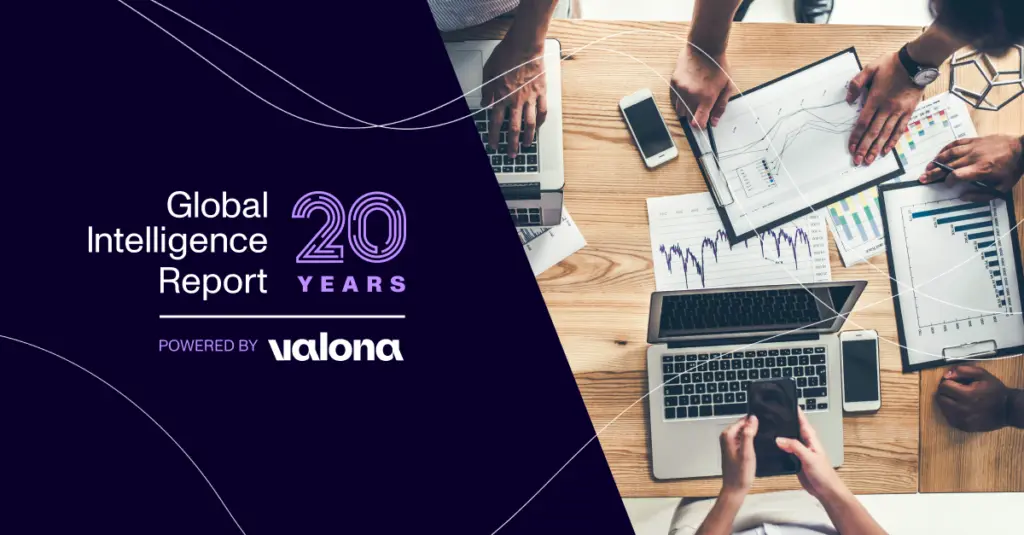
Industry Analysis: Heavy Industry in 2025
The Inflation Reduction and Infrastructure Investment and Jobs Acts are still making waves in 2025. Gain valuable insights and preparatory guidance with this analysis outlining how digital transformation in the manufacturing industry can change the way you do business.
This article discusses key trends to track changes in heavy industrial manufacturing throughout 2024 and beyond. A Valona analyst wrote this report using Valona’s platform.
Key trends impacting heavy
industrial manufacturing
Two powerful megatrends—digitalization and sustainability—are reshaping the future of the industrial manufacturing sector.
This analysis delves into the four key trends driving change and innovation in heavy industrial manufacturing, and by the end of this analysis, you will have a jumping-off point to better understand the following trends:
- Deglobalization and reshoring
- Electrification and low or-zero emissions
- Servitization
- Autonomous machinery
Read on to learn more about the challenges and opportunities driving this evolving sector forward.
1. Deglobalization of geopolitics and reshoring
What is it?
Companies are moving their manufacturing operations back to their home countries. We can see the trend through the declining global export-to-GDP ratio, especially in the US.1
Why are companies heading this way?
This is happening for two reasons: to prevent potential supply chain disruptions thanks to political instability, and partially because of incentives from legislation like the Infrastructure Investment and Jobs Act (IIJA). Companies want to regionalize production to prevent supply chain disruptions and material shortages. A mix of economic, geopolitical, and strategic factors influence this trend.
How does this affect the industry?
Companies are betting on the benefits of bringing their manufacturing operations back home and are taking steps to capitalize on these opportunities. Reshoring can also help heavy material companies better comply with environmental regulations and sustainability goals through vertical integration.
What can you do to prepare?
- Investigate your supply chain for a firm understanding of where potential disruptions might occur. Can you identify local suppliers, potential risks, and strong alternatives?
- Assess the operational costs of reshoring versus current costs. Look at market trends and competitor strategies to make an informed decision. Companies in steel and construction, specifically, are continuing to reshore operations for efficiency and quality control.2 Could this also be a good decision for you?
- Engage with local headlines, including governmental and community-related news, to understand local manufacturing benefits and regulations. Market research tools are a good way to identify potential partnerships and incentives.
“Investigate your supply chain for a firm understanding of where potential disruptions might occur. Can you identify local suppliers, potential risks, and strong alternatives?”
2. Electrification and low- or zero-emissions
What is it?
Low- or zero-emission solutions, like electrification, are becoming increasingly popular in the heavy industrial machinery sector. This is in part due to the United States’ Inflation Reduction Act, which provides more than US$270 billion in incentives for climate-friendly production.1
Why are companies heading this way?
Stricter emission regulations, carbon pricing policies, and government backing for clean technologies are driving energy-conscious operations. The heavy machinery industry plays a crucial role in supporting industries and communities to achieve decarbonization goals through sustainable, energy-efficient options
How does this affect the industry?
The transition to low- or zero-emission solutions is significant for the industry. Construction machinery alone accounts for approximately 1.1% of global CO2 emissions (equivalent to 400 MT). This is on par with emissions from international aviation. Half of this emission share is attributed to excavators.3
What can you do to prepare?
- Keep up-to-date on the latest in energy-efficient technologies and alternative fuels. This will guide your investments and research, giving you a competitive edge in preparing for a low-emission future.
- Use market intelligence tools to track and inform key stakeholders on regulations to ensure your company’s compliance.
- Invest in an R&D shift towards electrification, including exploring the use of hydrogen fuel cells or hybrid technologies.
“Keep up to date on the latest in energy-efficient technologies and alternative fuels. This will guide your investments and research, giving you a competitive edge in preparing for a low emission future.”
3. Servitization beyond point-of-sales
What is it?
The shift from only selling products to also offering services and solutions that complement those products, for instance, in the form of continuous, equipment-as-a-service models that offer as much as 2.5 times greater operating margins compared to pure equipment sales.1
Why are companies heading this way?
In a nutshell, the Internet of Things (IoT) and cloud computing allow heavy industrial manufacturers to offer more “as you go” services. Customers who use heavy machines are more inclined to lease rather than buy. Heavy industrial companies that switch to servitization are able to meet needs for integrated solutions as well as generate new, continuous revenue streams.4
How does this affect the industry?
Bain estimates that by 2030, most products in this industry will be sold as a bundle. More than 40% of 2023 acquisitions in heavy industry were for software and cloud computing capabilities. Servitization’s effect is twofold: it increases customer loyalty while providing insights into their needs and preferences.5
What can you do to prepare?
- Start market research to understand customer needs and tailor your services accordingly. Not only will this help boost revenue in the long run, but it will also show customers your commitment to product reliability.
- Dive into your competitive intelligence to understand what services your competitors offer and find ways to do it better. This will help you build recurring revenue and create stronger relationships with customers.
“Servitization’s effect is twofold: it will increase customer loyalty while providing insights into their needs and preferences.”
4. Autonomous and digitalized machinery
What is it?
Increasingly autonomous or semi-autonomous technologies are used in heavy equipment like bulldozers, excavators, cranes, and trucks. These technologies allow the machines to work with little human input, either by following preset instructions or using sensors and AI to make real-time decisions.
Why are companies heading this way?
Technological advancements, a growing need for efficiency and safety, and potential cost reductions are fueling a shift to autonomous machinery. The drive for autonomy is predicted
to continue expanding in the coming years.
How does this affect the industry?
This shift is expected to significantly change operations in the heavy machinery industry, potentially leading to more efficient, safe, and cost-effective processes.
What can you do to prepare?
- Conduct competitor research to identify technological and market demand trends in the industry.
- Consider partnering with/acquiring tech companies or
startups that specialize in autonomous technologies. - Keep an eye on the market, see what autonomous solutions they are offering. Learn from their successes and improve upon their shortcomings. Continually update your strategies based on changes in the competitive landscape.
“Technological advancements, a growing need for efficiency and safety, and potential cost reductions are fueling a shift to autonomous machinery.”
Sources
Valona has compiled this analysis by utilizing Valona Platform and global content sources, including government, media, and research institutions. Talk to us to find out how to get analyses like these regularly delivered to your inbox.
1 Deloitte: 2024 manufacturing industry outlook
2 World Trade Statistical Review 2023 (wto.org)
3 IDTechEx: Electric Construction Machines Vital for Greener Construction
4 Capgemini Equipment as a Service
5 Bain Machinery as a Service: A Radical Shift Is Underway




